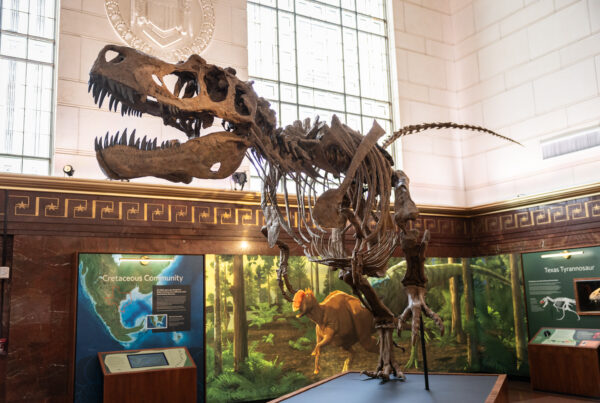What do you picture when you think of the word “museum”?
Is there marble in your picture? Tall ceilings and long corridors? What’s on the walls? How does it sound?
Texas Standard is kicking off a new regular segment called Texas Museum Map. Our idea is to explore and highlight museums across the Lone Star State – big and small, traditional and a little weird. Some of our choices might push the boundaries of a definition of a museum.
But wait, how do we define a museum? For help, we turned to Kenneth Hafertepe, a fellow with the Texas State Historical Association and chair of the Department of Museum Studies at Baylor. Listen to the interview above or read the transcript below.
This transcript has been edited lightly for clarity:
Texas Standard: So let’s start with that big question. How do you define a museum?
Kenneth Hafertepe: I think it’s fair to say that a museum has traditionally been thought of as a collection collected by someone who considered it to be significant – culturally significant, scientifically significant, or the like – and that they hope is going to be preserved for perpetuity.
So there are lots of subcategories of museums. What types typically come to mind?
Well, probably the most common types are art museums. It can also be history museums.
There has been an evolution in terms of science museums. They tended originally to be natural history, which some museums still use in their name. But it’s expanded to include a broader view of science to include physics and just all sorts of science.
Now, in addition to that, you have science centers where there isn’t necessarily a collection, a permanent collection, but newly built machines that help people understand scientific principles.
Related to those, you find newer types of museums, like children’s museum. And so those tend to be much more hands-on, much more interactive. And because of that, the offerings tend to be less rare objects – “here, play with this Picasso painting” or whatever – and more things that kids can use, explore, play with and then there’ll be another in the closet that you can bring out for the next kid.
 So collecting and sharing information sort of seem at least part at the core of what a museum is. Could my collection of Barbie dolls or vacuum cleaners be a museum if I opened up my home?
So collecting and sharing information sort of seem at least part at the core of what a museum is. Could my collection of Barbie dolls or vacuum cleaners be a museum if I opened up my home?
Well, it’s kind of like the person who decides that a painting, which makes no sense whatsoever to me, decides that it’s art. And if you have an artist and a person who buys and says, “this is beautiful, this is art,” by golly, you’ve got yourself a definition of art.
However, the American Alliance of Museums spent a lot of time trying to come up with a definition of what a museum actually is. To use a fancy phrase, it gives institutional parameters of what a museum is, which emphasizes both a collection, but a collection that is permanently held that’s cared for by a professional staff who present it to the public on a regular basis.
At some times we’ve thought that a museum needs to be a nonprofit, which most museums are – which is to say that you still have to pay to get into most museums, but there’s not anything left over at the end of the year that goes into the pockets of an owner or investors or that sort of thing. And most museums, if they have an excellent year, that surplus of money goes right back into planning for upgrades to the building or repairs to the building or all the expenses that just naturally happen in an institution.
Well, is it worth interrogating who has traditionally decided what is worth collecting or displaying?
It’s definitely worth interrogating what the motives are. I mean, in the very earliest time, some of the great collections tended to be the collections of kings or queens or noble people. Or the collection could be the collections of the Catholic Church.
How has the conversation over who owns history and where it rightly belongs been evolving over recent years?
The whole question of who owns a culture has kind of come back to haunt museums, in the sense that a collector may feel completely entitled to buy or even take artifacts from another culture.
In the very early years of the Smithsonian, a team of what was called “ethnologists” – studies of different ethnic groups – were sent to the southwest and in the 1880s collected a very wide variety of artifacts, including an altarpiece from the mission church, but also some sacred sculptures that pertained to Native religions, and that was particularly in the Zuni. So in the modern time, representatives of the Zuni have come to Washington and said, “hi, can we see the paperwork on your purchase of those artifacts from our pueblo?”
It’s the the good old principle of private property. If a museum can show that they paid a rightful price for an object from another culture, I think that they’re safe. Although one of the challenging topics as well is dealing with Nazi-looted art. There are actually records of Nazis paying for things out of the collections of Jewish families, but it was basically being done under duress.
I have a pop quiz for you. Do you have a favorite Texas museum?
This is a silly analogy, but how can you choose between your children?
The first Texas museum that I ever went to, or I should say historic site, was the Alamo in the aftermath of being a Davy Crockett fan and seeing both Davy Crockett on Wonderful World of Disney and then the John Wayne movie, which was kind of traumatic for a 6-year-old me.
The first museum that I ever worked with I have a fond place for, and that’s the French Legation State Historic Site in Austin, which I worked at as a tour guide back at the very end of my graduate school days. But, I have fond memories of going to the Dallas Museum of Art because I grew up in Dallas.
Probably I would not be in Texas right now if it was not for Miss Ima Hogg, who created the wonderful collection of American decorative arts at the Bayou Bend Collection, which is part of the Museum of Fine Arts Houston.
So there are so, so many that I enjoy.














